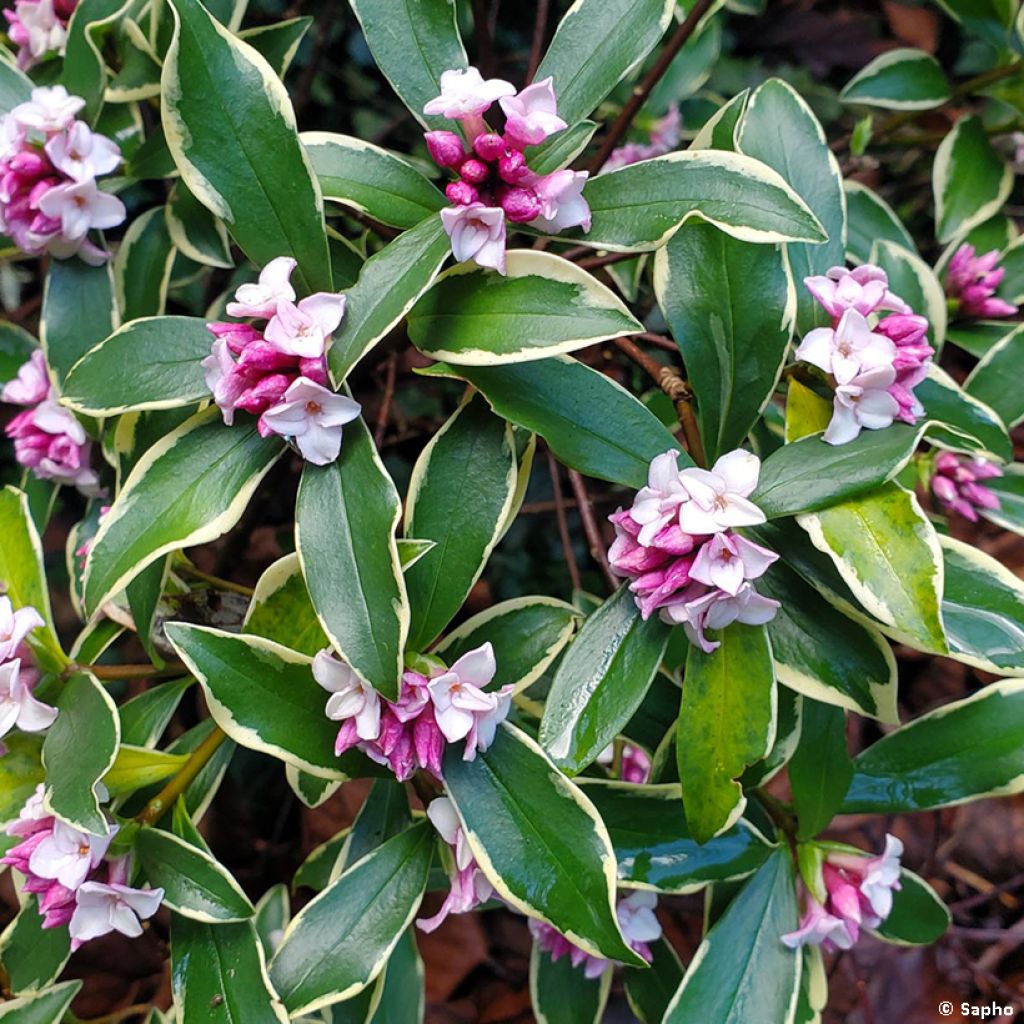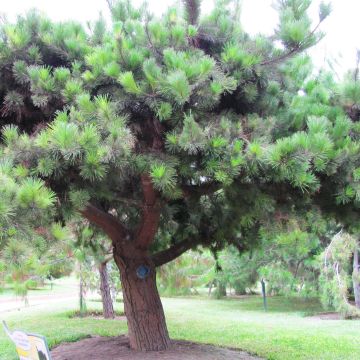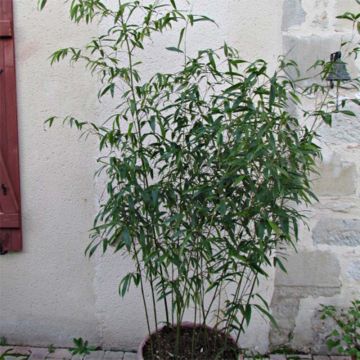

Daphne odora Rogald'or - Bois-joli
Daphne odora Rogaldor
Daphne odora Rogald'or
Winter Daphne, Fragrant Daphne
Special offer!
Receive a €20 voucher for any order over €90 (excluding delivery costs, credit notes, and plastic-free options)!
1- Add your favorite plants to your cart.
2- Once you have reached €90, confirm your order (you can even choose the delivery date!).
3- As soon as your order is shipped, you will receive an email containing your voucher code, valid for 3 months (90 days).
Your voucher is unique and can only be used once, for any order with a minimum value of €20, excluding delivery costs.
Can be combined with other current offers, non-divisible and non-refundable.
Home or relay delivery (depending on size and destination)
Schedule delivery date,
and select date in basket
This plant carries a 24 months recovery warranty
More information
We guarantee the quality of our plants for a full growing cycle, and will replace at our expense any plant that fails to recover under normal climatic and planting conditions.
Would this plant suit my garden?
Set up your Plantfit profile →
Description
The Daphne odora Rogald'or or fragrant daphne is a shrub whose flowering is among the most fragrant. Appearing during winter, the floral buds grouped in umbels at the end of the branches are very decorative with their deep pink color. They open into small, pale pink flowers with a romantic charm that perfume the air for weeks. The variegated foliage is also remarkable, composed of leaves with a beautiful green color highlighted by a yellow margin. A plant suited for mild climates, moderately hardy, with a compact habit, it is perfect for brightening shaded areas, in cool, neutral to acidic soil.
Daphne is a member of the little-known family Thymelaeaceae, which includes nearly 500 species, including Edgeworthia and Pimelea, with their characteristic terminal flower clusters. There are around fifty species of Daphne, shrubs or shrubby plants native to Europe (the most common being D. mezereum or Mezereon, despite its toxicity), North Africa, and Asia.
Daphne odora is a botanical species native to Japan and China, countries where it has been cultivated for hundreds of years. Its wood, rich in fibers, provides excellent traditional paper pulp. It is also a plant used in Asian pharmacopoeia, a subtle art that requires perfect mastery of dosages, as all parts of the plant are toxic.
Daphne Rogald'or is a horticultural hybrid created by the Polish breeder Przemyslaw Rogalski, also the breeder of the variety Daphne odora Marianni Rogbret (Gold Medal at the professional Innovert Show 2009). It is an improvement of the well-known Daphne odora 'Aureomarginata' appreciated by enthusiasts of the genus.
More compact than its predecessor, it forms a low-growing, slow-growing shrub, about 80 cm (31.5 in) in height and spread at maturity. These characteristics, coupled with moderate hardiness, encourage cultivation in containers in cold regions. It is particularly decorative with its beautiful evergreen foliage. It has lanceolate, narrow, pointed leaves of a superb green color enhanced by a fine, bright yellow margin all around the lamina.
Its slightly irregular, bushy habit gives it a very natural appearance, vaguely reminiscent of certain Rhododendrons with their slightly undulating, sometimes slightly drooping leaves. In winter, the tips of the branches are adorned with umbels, each containing about fifteen to twenty extremely decorative floral buds with their dark pink color, which contrasts beautifully with the foliage. The small flowers (about 1.5 cm (0.6 in)) are single, with 4 slightly pointed petals and a pale pink color that pleasantly coexists with the still closed dark buds. They bloom in February and March, for several weeks, spreading a delightful fragrance that combines carnation and jasmine. This fragrance is particularly welcome early in the season, heralding spring in the most beautiful way.
This shrub has moderate hardiness, up to about -10°C (14 °F) or -12°C (10.4 °F). In cold climates like those in the east, it can be perfectly cultivated in containers and overwintered in an unheated room, garage, or other room with a window.
Whether in the ground or in a container, place this Daphne Rogald'or in a high-traffic area to enjoy its intoxicating scent, in addition to its beautiful foliage. You can also integrate it into a diverse border, alongside other plants that thrive in cool shade. You can create a stunning scene by combining it with a Japanese Maple with red foliage, such as the beautiful Acer palmatum Twomblys Red Sentinel with a columnar habit. A Mountain Laurel such as the variety Ewa will take over the flowering after the Daphne, with its beautiful star-shaped buds opening into fused pink flowers. And for summer, you will find a wide range of Hydrangeas with various shapes and colors to suit your taste.
Note: Daphnes are sometimes temperamental plants, and their cultivation can be delicate if conditions are not suitable. They are best reserved for experienced gardeners.
Plant habit
Flowering
Foliage
Safety measures
Botanical data
Daphne
odora
Rogald'or
Thymelaceae
Winter Daphne, Fragrant Daphne
Cultivar or hybrid
ingestion
Cette plante est toxique si elle est ingérée volontairement ou involontairement.
Ne la plantez pas là où de jeunes enfants peuvent évoluer, et lavez-vous les mains après l'avoir manipulée.
Pensez à conserver l'étiquette de la plante, à la photographier ou à noter son nom, afin de faciliter le travail des professionnels de santé.
Davantage d'informations sur https://plantes-risque.info
Other Daphne
View all →Planting and care
The Daphne odora Rogald'or appreciates a slightly sunny position in the northern zone and a semi-shaded position further south, if possible in a location that is not exposed to spring frosts. Cultivate it in a rather fresh soil, neutral to slightly acidic, without limestone. The Daphne does not like to be transplanted, so choose its final location from the start and do not hesitate to plant a young plant, this way it will adapt more easily to the soil and exposure. Be careful not to damage the root ball during planting to avoid damaging the fragile roots. Soak the root ball for fifteen minutes in a bucket, while you dig a hole about 40 cm (15.7 in) in all directions. Mix slightly acidic planting compost with the existing soil, as well as draining materials (gravel, non-limestone coarse sand) if your soil tends to retain too much water in winter, position the root ball, backfill around it and then water abundantly. Apply compost on the surface every 2 years in spring, this will protect the roots from excessive heat. This Daphne has a rather slow growth and does not require pruning. Wear gloves when handling it, as the sap that comes out of it can irritate the skin.
Planting period
Intended location
Care
Planting & care advice
This item has not been reviewed yet - be the first to leave a review about it.
Similar products
Haven't found what you were looking for?
Hardiness is the lowest winter temperature a plant can endure without suffering serious damage or even dying. However, hardiness is affected by location (a sheltered area, such as a patio), protection (winter cover) and soil type (hardiness is improved by well-drained soil).

Photo Sharing Terms & Conditions
In order to encourage gardeners to interact and share their experiences, Promesse de fleurs offers various media enabling content to be uploaded onto its Site - in particular via the ‘Photo sharing’ module.
The User agrees to refrain from:
- Posting any content that is illegal, prejudicial, insulting, racist, inciteful to hatred, revisionist, contrary to public decency, that infringes on privacy or on the privacy rights of third parties, in particular the publicity rights of persons and goods, intellectual property rights, or the right to privacy.
- Submitting content on behalf of a third party;
- Impersonate the identity of a third party and/or publish any personal information about a third party;
In general, the User undertakes to refrain from any unethical behaviour.
All Content (in particular text, comments, files, images, photos, videos, creative works, etc.), which may be subject to property or intellectual property rights, image or other private rights, shall remain the property of the User, subject to the limited rights granted by the terms of the licence granted by Promesse de fleurs as stated below. Users are at liberty to publish or not to publish such Content on the Site, notably via the ‘Photo Sharing’ facility, and accept that this Content shall be made public and freely accessible, notably on the Internet.
Users further acknowledge, undertake to have ,and guarantee that they hold all necessary rights and permissions to publish such material on the Site, in particular with regard to the legislation in force pertaining to any privacy, property, intellectual property, image, or contractual rights, or rights of any other nature. By publishing such Content on the Site, Users acknowledge accepting full liability as publishers of the Content within the meaning of the law, and grant Promesse de fleurs, free of charge, an inclusive, worldwide licence for the said Content for the entire duration of its publication, including all reproduction, representation, up/downloading, displaying, performing, transmission, and storage rights.
Users also grant permission for their name to be linked to the Content and accept that this link may not always be made available.
By engaging in posting material, Users consent to their Content becoming automatically accessible on the Internet, in particular on other sites and/or blogs and/or web pages of the Promesse de fleurs site, including in particular social pages and the Promesse de fleurs catalogue.
Users may secure the removal of entrusted content free of charge by issuing a simple request via our contact form.
The flowering period indicated on our website applies to countries and regions located in USDA zone 8 (France, the United Kingdom, Ireland, the Netherlands, etc.)
It will vary according to where you live:
- In zones 9 to 10 (Italy, Spain, Greece, etc.), flowering will occur about 2 to 4 weeks earlier.
- In zones 6 to 7 (Germany, Poland, Slovenia, and lower mountainous regions), flowering will be delayed by 2 to 3 weeks.
- In zone 5 (Central Europe, Scandinavia), blooming will be delayed by 3 to 5 weeks.
In temperate climates, pruning of spring-flowering shrubs (forsythia, spireas, etc.) should be done just after flowering.
Pruning of summer-flowering shrubs (Indian Lilac, Perovskia, etc.) can be done in winter or spring.
In cold regions as well as with frost-sensitive plants, avoid pruning too early when severe frosts may still occur.
The planting period indicated on our website applies to countries and regions located in USDA zone 8 (France, United Kingdom, Ireland, Netherlands).
It will vary according to where you live:
- In Mediterranean zones (Marseille, Madrid, Milan, etc.), autumn and winter are the best planting periods.
- In continental zones (Strasbourg, Munich, Vienna, etc.), delay planting by 2 to 3 weeks in spring and bring it forward by 2 to 4 weeks in autumn.
- In mountainous regions (the Alps, Pyrenees, Carpathians, etc.), it is best to plant in late spring (May-June) or late summer (August-September).
The harvesting period indicated on our website applies to countries and regions in USDA zone 8 (France, England, Ireland, the Netherlands).
In colder areas (Scandinavia, Poland, Austria...) fruit and vegetable harvests are likely to be delayed by 3-4 weeks.
In warmer areas (Italy, Spain, Greece, etc.), harvesting will probably take place earlier, depending on weather conditions.
The sowing periods indicated on our website apply to countries and regions within USDA Zone 8 (France, UK, Ireland, Netherlands).
In colder areas (Scandinavia, Poland, Austria...), delay any outdoor sowing by 3-4 weeks, or sow under glass.
In warmer climes (Italy, Spain, Greece, etc.), bring outdoor sowing forward by a few weeks.





















































